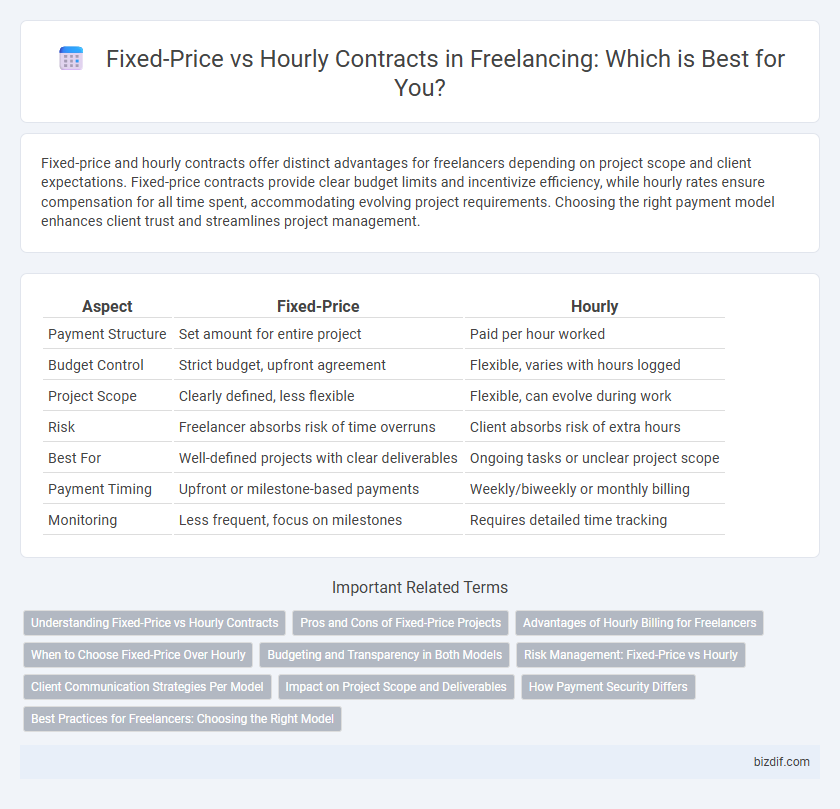Fixed-price and hourly contracts offer distinct advantages for freelancers depending on project scope and client expectations. Fixed-price contracts provide clear budget limits and incentivize efficiency, while hourly rates ensure compensation for all time spent, accommodating evolving project requirements. Choosing the right payment model enhances client trust and streamlines project management.
Table of Comparison
| Aspect | Fixed-Price | Hourly |
|---|---|---|
| Payment Structure | Set amount for entire project | Paid per hour worked |
| Budget Control | Strict budget, upfront agreement | Flexible, varies with hours logged |
| Project Scope | Clearly defined, less flexible | Flexible, can evolve during work |
| Risk | Freelancer absorbs risk of time overruns | Client absorbs risk of extra hours |
| Best For | Well-defined projects with clear deliverables | Ongoing tasks or unclear project scope |
| Payment Timing | Upfront or milestone-based payments | Weekly/biweekly or monthly billing |
| Monitoring | Less frequent, focus on milestones | Requires detailed time tracking |
Understanding Fixed-Price vs Hourly Contracts
Fixed-price contracts require a set payment for the complete project, providing clear budget expectations and minimizing financial risk for clients. Hourly contracts compensate freelancers based on time spent, offering flexibility for projects with evolving scopes and detailed tracking of work hours. Choosing between fixed-price and hourly depends on project clarity, scope certainty, and the preference for payment predictability or adaptability.
Pros and Cons of Fixed-Price Projects
Fixed-price projects offer freelancers clear payment terms and defined project scopes, reducing the risk of unpaid work and budget overruns. However, they can limit flexibility when unexpected tasks arise and may require precise project estimation skills to avoid underpayment. Clients benefit from predictable costs, but miscommunication or scope changes can lead to disputes or delays.
Advantages of Hourly Billing for Freelancers
Hourly billing allows freelancers to accurately capture time spent on complex projects, ensuring fair compensation for all work hours. This method provides flexibility to adjust scope and effort without frequent contract renegotiations, reducing potential disputes. Tracking hours also enhances transparency and builds trust with clients through detailed time logs and progress updates.
When to Choose Fixed-Price Over Hourly
Fixed-price contracts are ideal for projects with clearly defined scopes and deliverables, ensuring budget certainty and streamlined payment processes. When the project requirements are stable and the freelancer can accurately estimate the time and resources needed, fixed-price agreements minimize the risk of scope creep and unexpected costs. Choosing fixed-price contracts also benefits clients seeking predictable expenses and freelancers aiming to maximize efficiency within set parameters.
Budgeting and Transparency in Both Models
Fixed-price contracts provide clear budgeting by defining a total project cost upfront, ensuring clients know the exact expense without surprises. Hourly models offer transparency through detailed timesheets and logs, enabling clients to track hourly progress and adjust scope accordingly. Both approaches require clear communication to balance budget certainty with flexibility during project execution.
Risk Management: Fixed-Price vs Hourly
Fixed-price contracts minimize the risk of budget overruns by setting a clear payment amount, but they can increase the risk of scope creep if project requirements are not well-defined from the start. Hourly contracts offer flexibility to adjust project scope and timeline, reducing the risk of misaligned expectations but potentially leading to unpredictable total costs. Effective risk management in freelancing involves selecting the pricing model that best aligns with project complexity and client communication clarity.
Client Communication Strategies Per Model
Fixed-price projects require clear, upfront communication to define scope, deliverables, and milestones, minimizing misunderstandings and ensuring alignment on expectations. Hourly contracts benefit from ongoing dialogue and regular updates, allowing clients to monitor progress and approve adjustments in real time. Tailoring communication frequency and detail to the payment model enhances transparency and client satisfaction.
Impact on Project Scope and Deliverables
Fixed-price contracts offer clear project scope and defined deliverables, minimizing the risk of scope creep and ensuring budget predictability. Hourly contracts provide flexibility to adapt project requirements and deliverables as work progresses, accommodating changes but potentially increasing costs. The choice between fixed-price and hourly impacts how project scope is managed and how deliverables are structured and delivered.
How Payment Security Differs
Fixed-price contracts offer payment security by requiring clients to fund milestones in escrow before work begins, ensuring freelancers are paid upon approved deliverables. Hourly contracts rely on time-tracking tools like Upwork's Work Diary, providing transparency to clients and guaranteed hourly wage protection for freelancers. Disputes in fixed-price projects often involve milestone reviews, while hourly contracts depend on accurate time logs to resolve payment issues efficiently.
Best Practices for Freelancers: Choosing the Right Model
Freelancers should evaluate project scope and client preferences when choosing between fixed-price and hourly models to maximize earnings and minimize risks. Fixed-price contracts work best for well-defined tasks with clear deliverables, while hourly rates suit projects requiring flexibility and ongoing adjustments. Applying transparent communication and setting realistic expectations enhances client trust and project success regardless of the payment structure.
Fixed-price vs Hourly Infographic

 bizdif.com
bizdif.com